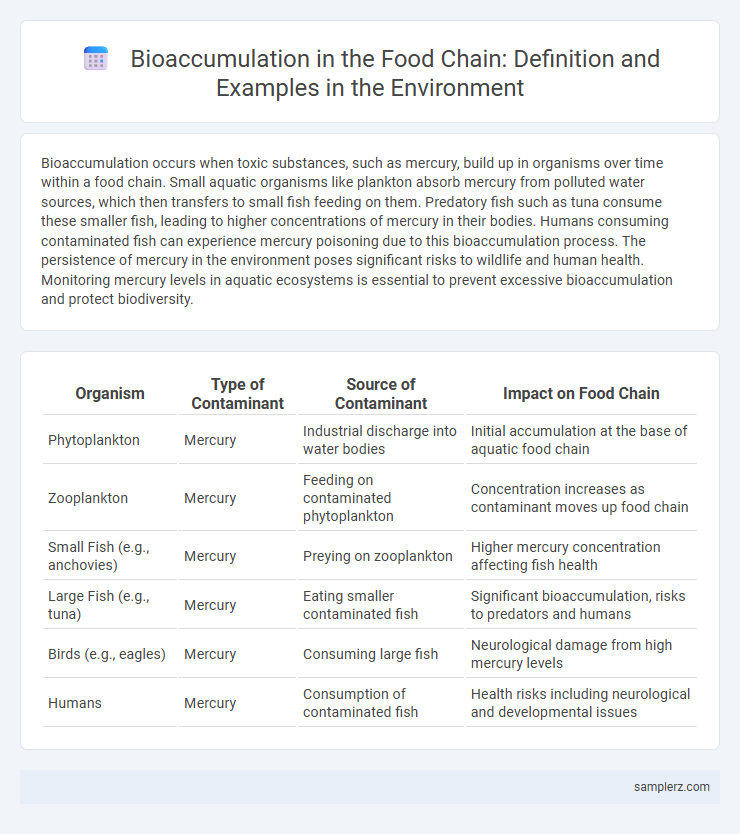Bioaccumulation occurs when toxic substances, such as mercury, build up in organisms over time within a food chain. Small aquatic organisms like plankton absorb mercury from polluted water sources, which then transfers to small fish feeding on them. Predatory fish such as tuna consume these smaller fish, leading to higher concentrations of mercury in their bodies. Humans consuming contaminated fish can experience mercury poisoning due to this bioaccumulation process. The persistence of mercury in the environment poses significant risks to wildlife and human health. Monitoring mercury levels in aquatic ecosystems is essential to prevent excessive bioaccumulation and protect biodiversity.
Table of Comparison
| Organism | Type of Contaminant | Source of Contaminant | Impact on Food Chain |
|---|---|---|---|
| Phytoplankton | Mercury | Industrial discharge into water bodies | Initial accumulation at the base of aquatic food chain |
| Zooplankton | Mercury | Feeding on contaminated phytoplankton | Concentration increases as contaminant moves up food chain |
| Small Fish (e.g., anchovies) | Mercury | Preying on zooplankton | Higher mercury concentration affecting fish health |
| Large Fish (e.g., tuna) | Mercury | Eating smaller contaminated fish | Significant bioaccumulation, risks to predators and humans |
| Birds (e.g., eagles) | Mercury | Consuming large fish | Neurological damage from high mercury levels |
| Humans | Mercury | Consumption of contaminated fish | Health risks including neurological and developmental issues |
Introduction to Bioaccumulation in Food Chains
Bioaccumulation occurs when toxins like mercury accumulate in organisms at each trophic level of a food chain, starting from microscopic algae to large predatory fish such as tuna. Mercury concentrations increase significantly in top predators, posing health risks to species higher in the food web, including humans who consume contaminated seafood. This phenomenon highlights the persistent nature of pollutants and their amplified impact through aquatic ecosystems.
Mercury Accumulation in Aquatic Food Webs
Mercury bioaccumulation occurs prominently in aquatic food webs, where inorganic mercury is converted by bacteria into methylmercury, a highly toxic form that biomagnifies through trophic levels. Predatory fish such as tuna, swordfish, and shark exhibit the highest mercury concentrations due to their position atop the food chain, posing significant health risks to humans and wildlife consuming them. Monitoring mercury levels in aquatic ecosystems is crucial for managing pollution sources and protecting biodiversity.
Persistent Organic Pollutants in Marine Life
Persistent Organic Pollutants (POPs) such as polychlorinated biphenyls (PCBs) accumulate in marine organisms, starting with plankton and moving up the food chain to fish, marine mammals, and humans. These toxic chemicals persist in the environment and bioaccumulate due to their resistance to degradation and fat solubility, leading to higher concentrations in top predators like sharks and whales. The biomagnification of POPs causes health risks including reproductive issues and immune system damage in marine wildlife.
DDT Biomagnification in Birds of Prey
DDT undergoes biomagnification in birds of prey, where this persistent pesticide accumulates at increasing concentrations up the food chain. Small aquatic organisms absorb DDT from contaminated water, which is then ingested by fish, and subsequently by larger predatory birds such as eagles and hawks. These top predators experience toxic effects including reproductive failure and eggshell thinning due to the high DDT levels concentrated in their tissues.
PCBs in Freshwater Ecosystems
Polychlorinated biphenyls (PCBs) bioaccumulate in freshwater ecosystems as they persist in sediments and aquatic organisms, concentrating upward through the food chain from plankton to predatory fish. Studies show that PCB levels in top predator fish species can be millions of times higher than those in surrounding water due to their lipid-soluble nature and resistance to metabolic breakdown. This biomagnification threatens biodiversity and poses significant health risks to wildlife and humans consuming contaminated fish.
Arsenic Accumulation in Rice and Seafood
Arsenic accumulation in rice occurs through contaminated water and soil, posing significant health risks to populations relying on rice as a staple food. Seafood, especially shellfish and fish from polluted waters, also bioaccumulates arsenic, leading to elevated exposure levels in humans consuming these products. Monitoring arsenic levels in both rice fields and marine ecosystems is critical for preventing toxic bioaccumulation and safeguarding food safety.
Heavy Metals in Terrestrial Food Chains
Heavy metals such as lead, mercury, and cadmium accumulate progressively in terrestrial food chains, starting from contaminated soil and plants to herbivores and apex predators. Bioaccumulation of these toxic metals poses severe health risks to wildlife, including neurological damage and reproductive failure. Monitoring heavy metal concentrations in key species helps assess ecosystem health and informs strategies for pollution mitigation and environmental protection.
Trophic Transfer of Toxins in Arctic Ecosystems
In Arctic ecosystems, bioaccumulation of toxins such as mercury and persistent organic pollutants (POPs) occurs prominently through trophic transfer among species like plankton, fish, seals, and polar bears. These toxins concentrate at higher trophic levels, causing significant health risks and reproductive issues in apex predators. Monitoring the biomagnification of contaminants highlights the vulnerability of Arctic food webs to environmental pollution and climate change impacts.
Microplastics and Bioaccumulation in Aquatic Species
Microplastics accumulate in aquatic species as small fish ingest them, which are then consumed by larger predators, leading to a concentration of these particles along the food chain. Studies reveal that microplastics can cause physical and chemical harm, affecting reproduction and growth in fish such as sardines and anchovies. This bioaccumulation poses risks not only to marine ecosystems but also to human health through seafood consumption.
Preventing and Managing Bioaccumulation Risks
Preventing and managing bioaccumulation risks requires monitoring toxic substances such as mercury and persistent organic pollutants in aquatic ecosystems where these contaminants concentrate in plankton and move up the food chain to fish and humans. Implementing regulations on industrial emissions and promoting the use of safer alternatives can reduce the input of harmful chemicals into the environment, thereby minimizing bioaccumulation. Restoring wetlands and promoting biodiversity also help break the accumulation cycle by supporting organisms that metabolize or sequester toxins, reducing overall ecological and health risks.

example of bioaccumulation in food chain Infographic
 samplerz.com
samplerz.com